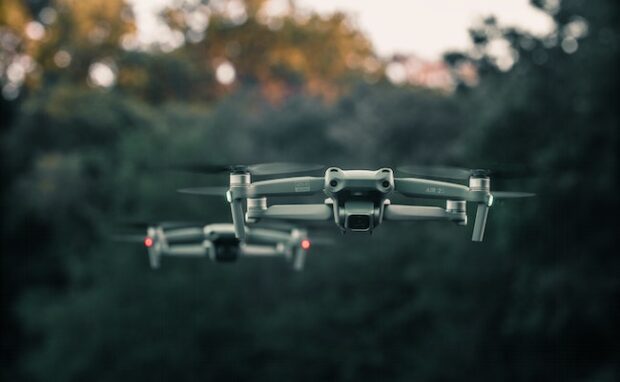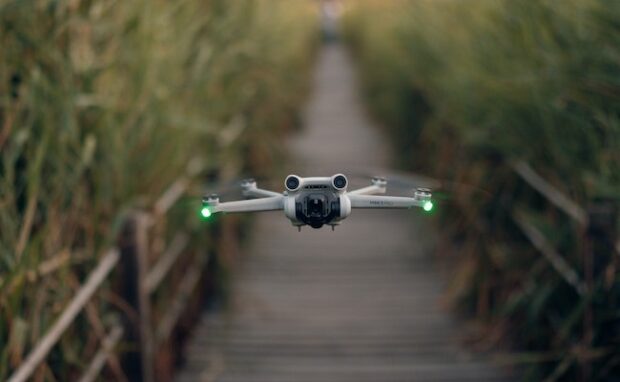AI algorithm prepares us for a drone-filled future
Johns Hopkins Institute for Assured Autonomy researchers created an artificial intelligence algorithm for managing drone traffic. Many experts believe the future will have more uncrewed aircraft systems (UAS) flying in public for various purposes. In response, many private and public sector groups like Johns Hopkins are developing systems to manage it.
Science news website Interesting Engineering says drones are gaining more practical applications. Consequently, our future will have more autonomous flying machines performing various tasks. By 2027, the US will likely have a million drones delivering packaging, monitoring road traffic, and providing emergency aid.
If we don’t act now, the future may involve too many drones crashing into each other. This article will discuss how the AI drone algorithm works. Then, I will cover some of the latest drone innovations.
How did researchers create this AI drone algorithm?

The Johns Hopkins researchers started their project by evaluating the impact of autonomous algorithms in a simulated 3D environment. They know from previous research that using collision avoidance algorithms significantly reduced accidents.
Then, the experts added strategic deconfliction algorithms to boost safety further. They control traffic timing to avoid collisions, eliminating nearly all airspace accidents.
The experts also added two realistic factors to their simulator. First, they added “noisy sensors” that mimic the unpredictability of real-world conditions.
After all, the urban outdoors often fills with car horns, public chatter, and other loud sounds. Second, the researchers added a “fuzzy interference system,” which calculates the risk level for drones based on various factors.
“We wanted to see if different approaches using AI could handle the expected scale of these operations in a safe manner, and it did,” said researcher Lanier Watkins. “Our simulated system leverages autonomy algorithms to enhance the safety and scalability of UAS operations below 400 feet altitude,” he added.
These include proximity to obstacles and adherence to a specific route. The researchers said these factors enabled their system to make autonomous decisions to prevent crashes.
You may also like: Photoshop gains Generative Fill AI feature
“Our study considered a variety of variables, including scenarios that involve ‘rogue drones’ that deviated from their planned routes. The results are very promising,” said one of the researchers, Louis Whitcomb.
The team plans to improve simulations further by adding dynamic obstacles like weather and similar real-world factors. “This work helps researchers understand how autonomy algorithms that protect airspace can behave when faced with noise and uncertainty in 3D-simulated airspace,” stated Watkins.
Meanwhile, the Federal Aviation Agency acknowledges the issue and plans to solve it with a UAS traffic management (UTM) system. The Johns Hopkins AI drone algorithm might become a part of it.
What are the latest drone projects?
We are approaching a drone-filled future as Amazon tests delivering goods with uncrewed flying machines. After all, it is one of the largest e-commerce companies in the world.
It has been performing trials for its upcoming Amazon Prime Air service. At the time of writing, it is undergoing initial testing in Lockeford, California, and College Station, Texas.
Residents may sign up to have drones carry their packages weighing up to 5 lbs. The best part is these drones use artificial intelligence to deliver goods without the need for human operators.
Amazon Air spokesperson Natalie Banke told KTXL Fox 40, “Our aim is to safely introduce our drones to the skies. We are starting in these communities and will gradually expand deliveries to more customers over time.”
You may also like: Could drones snuff out fireworks?
Meanwhile, Wilmington City, Delaware, partnered with Drone Workforce Solutions Drone School (DWS) for drone classes in schools. They divided lessons into a 16-week training course and a four-week virtual reality class for teens.
The first focuses on basic drone operation and related technologies. On the other hand, the second uses virtual reality technology to simulate environments for training. It will be at the Williams “Hicks” Anderson Community Center on 501 North Madison Street.
The city will provide scholarships to its 11th and 12th graders to subsidize lessons and equipment. Moreover, completing the courses provides a six-to-12-week paid internship and opens the FAA exam to help passers become licensed drone pilots.
Conclusion
Johns Hopkins Institute researchers developed an AI drone algorithm to prevent these flying machines from crashing into each other. We would need one as drones become more widely used worldwide.
The team admitted it needed more time and research to refine its artificial intelligence. Nevertheless, other countries would likely develop similar systems.
Read more about this AI drone algorithm study on the IEEE Spectrum website. Also, learn more about the latest digital tips and trends at Inquirer Tech.
